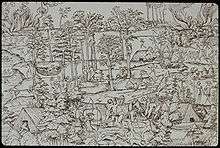Ethnographic village
An ethnographic village is a real or artificial settlement which portrays complete historical and ethnographic characteristics of life of a certain ethnic group. The concept is close to that of an open-air museum or "living museum."
Ethnographic village exhibitions

As early as in 1550 a mock Brazilian village was built by Rouen, France, on an occasion of the entry of king Henry II of France. For this purpose, Brazilian flora and fauna were imported, and typical Amerindian dwellings were built. The village was populated by 50 original Tabajara and Tupinambá people as well as about 250 French dressed as "natives".[1][2]
Similar "Negro villages" has become increasingly common in various places, becoming a staple feature of international exhibitions of late 19th-early 20th centuries, such as the 1889 Paris Exposition.[3]
Since these villages commonly emphasized the backwards, "savage" ways of life as compared to European civilization, the concept was criticized as a manifestation of racism.
Real settlements
Lithuania
In modern Lithuania, an ethnographic village (Lithuanian: etnografinis kaimas) is defined as a rural settlement which maintains traditional, historical, ethnic cultural characteristics specific to the particular region. These characteristic include traditional architecture, farmstead planning, relation to the natural landscape, as well as traditional life, including farming traditions, arts and crafts.[4]
References
- Alison Griffiths, "Wondrous difference: cinema, anthropology & turn-of-the-century visual culture", Columbia University Press, 2002, ISBN 0-231-11697-7, p. 52
- "France and Brazil in the First Century of Contact: The Lure of Brazilwood" Archived 2010-07-07 at the Wayback Machine, from the Newberry Library slidesets
- Alison Griffiths,p. 59
- "Lietuvos etnografinių kaimų išlikimo ilgalaikės programos projektas" (Project of the long-term program for preservation of Lithuanian ethnographic villages)